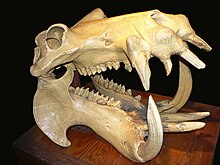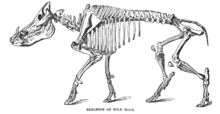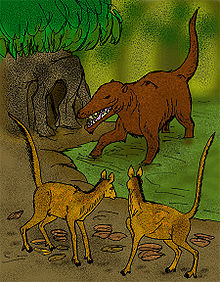Suina
| Suina | |
|---|---|

| |
| Potamochoerus porcus | |
| Scientific classification | |
| Kingdom: | |
| Phylum: | |
| Class: | |
| Order: | |
| Suborder: | Suina Gray, 1868
|
| Families | |
|
Suidae But see article | |
The suborder Suina (also known as Suiformes) contains perhaps the earliest and most archaic even-toed ungulates.
Classification
There are only three families alive today:
- Family Suidae (pigs, hogs)
- Family Tayassuidae (peccaries)
- Family Hippopotamidae (hippopotami) - currently disputed (see Cetartiodactyla)
The oreodonts of the possibly-ancestral family Oreodontidae (best known for the genus Oreodon, a.k.a. Merycoidodon) are now extinct. Sometimes called "ruminating hogs," they were pig-like, cud-chewing plant-eaters with tusk-like canine teeth, short faces, and four-toed hooves. Although some scholars place them within the suborder Suina, others put them in their own suborder, named Oreodonta. The extinct Entelodonts are often regarded as members of the Suina as well.
Hippopotamus were once thought to be part of the Suina, but recent data suggested that they're more related the Cetacean. However, it's possible that the whales and hippos sort of branch off the Suina, making them distant relatives (see Hippopotamus#Taxonomy and origins). And if it is true that they're distant relatives in (and of) the Suina, then that means that the cetacean's families are part of the Suina:
- Family Suidae (pigs, hogs)
- Family Tayassuidae (peccaries)
- Family Hippopotamidae (hippopotami)
- Family Delphinidae (oceanic dolphins)
- Family Monodontidae (Narwhal and Beluga)
- Family Phocoenidae (porpoise)
- Family Ziphiidae (beaked whale)
- Family Kogiidae (Kogia sperm whales)
- Family Physeteridae (Physeter sperm whales)
- Family Platanistidae (Ganges and Indus River Dolphin)
- Family Iniidae (Amazon River Dolphin)
- Family Lipotidae (Chinese River Dolphin or Baiji)
- Family Pontoporiidae (La Plata Dolphin)
- Family Neobalaenidae (pygmy right whales)
- Family Balaenidae (right whales)
- Family Balaenopteridae (rorquals)
- Family Eschrichtiidae (gray whales)
However, it will most likely that the cetacean families won't be part of the Suina.
These prehistoric artiodactyls were very common amid the dry grasslands of North and Central America throughout much of the Cenozoic era. Their teeth are often found as fossils amid the Oreodon beds in South Dakota, Nebraska, and Wyoming.
The primordial oreodonts appeared 48 million years ago (m.y.a.) during the Eocene epoch of the Paleogene period, but became extinct 4 m.y.a. during the early Pliocene epoch of the Neogene period. It is not known whether they were ancestral to the living genera of Suina.
Anatmony

The anatmony of the Suina is a very primitive from that of other even-toed ungulates. For example, they have teeth. This let let them chew the food. Most of the other mammals, like goats and deer, have teeth only on the bottom. This doesn't let them chew very well, so they have to shallow it and regertitate the food so they could chew it more.
Most even-toes, have a four-chambered stomach. The Suina do no have a four-chambered stomach, since they have a simple kind of stomach that is evoled more into digesting anything that the Suina animals can eat.


Along with that, most of them have toes instead of hoofs. Some, like hippos, have four-toes at front and three on the back. While other even-toed have cloven feet. Also the leg structure is different from other even-toed. While most even-toed, and some Suina, have long slender legs, the Suina don't. They have short, stubby legs. However due to the contary of the legs, they can run very fast. Best example is the hippo. They can run 35 mph.
Evolution
See also in Evolution of cetaceans and Hippopotamus#Evolution
The origins of these animals, have also played a big role for the Cetacean and other even-toed ungulates as well. Also their evolution is relatively well known, due to the large fossils being plentiful. But when the cetaceans came, their was big debate.


Around 63 million years ago, a genet-like creature evoled. This creatue didn't look like the ancestor of Cetartiodactyla. The animal climbed into the trees and hunted at night like a gennet. Chriacus was the name. This animal was the ancestor of two species in 9 million years (or 54 million years ago). Diacodexis and Pakicetus. These were two were the earliest members of their family. As millions of years went, these went their seprate ways. Pakicetus would evoled into more stream-line and more advance able to hold their breath for a very long time. Some would lose their teeth and have baleen. Pakicetus evolved into the Cetacean group.
As for Diacodexis, it evoled into the Suina group. The early members of the Suina were more like Diacodexis. As they evolved, they evolved into the oreodonts. Then the anthracotheres branch broke up and some evoled into our hippos. Then the peccaries branch came and evolved in the Americas. Another branch broke off and it was the other even-toed ungulates. Then millions of years went by, the entelodonts and the true pigs branch came in the Old World.
